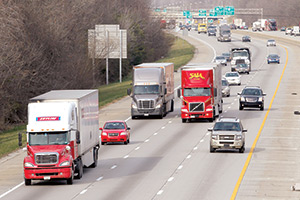Senior Reporter
Trucking Responds to Limiter Proposal

This story appears in the Dec. 19 & 26 print edition of Transport Topics.
In written comments to federal regulators, several large trucking companies and trade organizations echoed concerns of owner-operators that a proposed rule for a heavy-truck speed limiter will not improve safety on U.S. highways, and may even cause more crashes due to speed differentials.
Although some owner-operator drivers said the rule would favor large trucking companies, the negative reaction to the proposal was frequently shared by some of the industry’s largest carriers.
The joint proposal from the Federal Motor Carrier Safety Administration and National Highway Traffic Safety Administration calls for all new heavy trucks to be speed-limited at 60, 65 or 68 mph, but does not specify which speed it favors. The comment period closed Dec. 7.
Comments by American Trucking Associations were representative of concerns expressed in the overwhelming majority of the 4,500 comments posted.
ATA said it supports speed limiters governed at 65 mph, but only if passenger cars are limited to the same speed as trucks.
“ATA’s foremost concern with the proposal is that it fails to adequately demonstrate that the speed differentials it will engender between heavy trucks and passenger vehicles will not create new safety hazards that would offset anticipated safety gains,” ATA wrote.
YRC Worldwide Inc. said its trucks have been speed-limited for decades, but the carrier nonetheless called for further research before a recommendation is made that links safety and environmental benefits to a specific speed.
Truck driver David Bloom, who said he has logged 2.5 million miles with no preventable accident, said the proposed mandate is “based on special interest groups and the furthering of their agenda, and not on scientific facts and studies conducted by actual safety organizations.”
“Speed limiters on trucks not only will not reduce accidents, but will cause more frustration and aggression by the drivers of surrounding vehicles,” Bloom wrote.
Werner Enterprises said it has identified many areas of deficiencies that need to be further addressed prior to a final rule being issued.
“The most concerning aspect of the rule is the threat of a significant speed differential,” Werner wrote.
But remarks by Roehl Transport, J.B. Hunt Transport and Covenant Transportation Group sided with regulators.
“It is a proven fact that the greater the speed of any vehicle, the greater the severity when a collision occurs, especially when a moving commercial motor vehicle with a gross vehicle weight rating of greater than 26,000 [pounds] is involved,” Hunt wrote. “Reducing the maximum speed of CMVs as proposed by the [notice of proposed rule making] only makes logical sense.”
Hunt said it believes an 80,000- pound tractor-trailer rear-ending an automobile poses a much more serious safety risk than a car rear-ending a truck due to a speed variation between a slower moving lead vehicle.
Roehl and Covenant have been speed limiting their trucks for many years.
“We regularly travel in states with higher speed limits,” Roehl wrote. “Since governing our trucks, we find that the difference in a higher speed limit and our governed speed is not a contributing factor to accidents we have been involved in.”
Likewise, Covenant said that most of its trucks are governed at 65 mph and that it has not experienced a significant number of accidents in a split-speed environment, nor additional congestion.
Nasstrac Inc. said it believes the speed limiters could lead to modest delays in deliveries.
“Though this result is not something most Nasstrac members would welcome, it is not the reason we oppose the agencies’ speed limiter proposals,” the shipper group wrote. “Rather, we believe the proposals have been inadequately researched, developed and explained, and we share the concern of many trucking companies that a speed limiter mandate, as currently proposed, would do more harm than good.”

